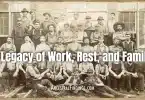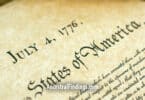In the mid-19th century, the United States was a young and burgeoning nation, bursting with ambition and a sense of purpose. This period was marked by a powerful belief that it spurred westward expansion, reshaped the continent, and left an indelible mark on American history. This belief was known as Manifest Destiny.
The Birth of an Idea
The term “Manifest Destiny” was first coined by journalist John L. O’Sullivan in 1845. He articulated that Americans were divinely ordained to expand across the North American continent, spreading democracy and civilization. This idea wasn’t merely a call to adventure; it was perceived as a moral duty and a natural right. Imagine the sense of destiny that must have filled the hearts of settlers as they looked westward, dreaming of fertile lands and new opportunities.
Westward Ho! The Journey Begins
As the 19th century progressed, the spirit of Manifest Destiny inspired thousands of families to pack their belongings into covered wagons and set off on perilous journeys across unknown territories. The Oregon Trail, stretching over 2,000 miles from Missouri to the lush valleys of Oregon, symbolized this epic migration. Picture families trudging through vast prairies, crossing treacherous rivers, and braving the rugged Rocky Mountains, all driven by the promise of a better life.
One such family was the Donners, whose tragic tale became infamous. Trapped by early snow in the Sierra Nevada during the winter of 1846-1847, the Donner Party’s ordeal highlighted the harsh realities of the journey. Yet, despite such dangers, the westward movement continued, fueled by the belief in Manifest Destiny.
The Mexican-American War and Territorial Expansion
Manifest Destiny was also crucial in the Mexican-American War (1846-1848). Driven by the desire to expand, President James K. Polk sought to acquire California and New Mexico from Mexico. The war, though controversial, resulted in the Treaty of Guadalupe Hidalgo, which added vast territories to the United States. This expansion fulfilled the vision of Manifest Destiny and intensified debates over slavery, setting the stage for future conflicts.
The Gold Rush: A Feverish Quest for Fortune
The discovery of gold at Sutter’s Mill in California in 1848 ignited the Gold Rush, drawing thousands of prospectors, known as “forty-niners,” to the West. The promise of untold wealth acted like a magnet, pulling people from all walks of life into the frenzy. Imagine the bustling mining camps, the feverish panning of streams, and the dreams of striking it rich. The Gold Rush epitomized the spirit of Manifest Destiny, showcasing the lengths to which people would go to fulfill their destiny.
Impact on Indigenous Peoples
While Manifest Destiny propelled American expansion, it had devastating consequences for Indigenous peoples. The relentless push westward led to the displacement and suffering of countless Native American tribes. The infamous Trail of Tears, where thousands of Cherokee were forcibly removed from their ancestral lands, is a stark reminder of this dark chapter. The belief in Manifest Destiny often overshadowed the rights and humanity of the native inhabitants, leaving a legacy of injustice that echoes to this day.
The Homestead Act: Encouraging Settlement
To further encourage westward expansion, the Homestead Act of 1862 was enacted. This legislation offered 160 acres of public land to settlers willing to farm it for at least five years. The act opened up millions of acres for settlement, drawing a diverse array of immigrants, freed slaves, and Easterners seeking new beginnings. The homesteaders faced immense challenges, from building sod houses on the treeless plains to enduring harsh winters and droughts. Yet, the promise of land ownership kept their spirits high, and many thrived, transforming the American landscape.
The Transcontinental Railroad: Uniting a Nation
Completing the Transcontinental Railroad in 1869 marked a monumental achievement in fulfilling Manifest Destiny. Linking the East and West coasts, the railroad revolutionized travel and commerce. Imagine the excitement of passengers boarding the train in New York and arriving in San Francisco in just a week—a journey that once took months. The railroad not only facilitated migration and trade but also symbolized the technological prowess and unity of the nation.
The Cultural Legacy of Manifest Destiny
Manifest Destiny left a profound cultural legacy. It inspired art, literature, and music, celebrating the pioneer spirit and the vast American frontier. Painters like Albert Bierstadt captured the breathtaking landscapes of the West, while writers such as Walt Whitman extolled the virtues of expansion in their works. The concept also shaped American identity, fostering a sense of exceptionalism and a belief in the nation’s unique role in the world.
The End of the Frontier
By the end of the 19th century, the American frontier was declared “closed” by the U.S. Census Bureau. The era of Manifest Destiny had achieved its goal—the contiguous United States stretched from the Atlantic to the Pacific. Completing this grand vision, however, came with a complex legacy. While it spurred growth and development, it also brought about environmental degradation, conflicts with Indigenous peoples, and the displacement of numerous communities.
Reflecting on Manifest Destiny Today
Today, Manifest Destiny remains a controversial and multifaceted topic. It embodies the pioneering spirit and ambition that helped shape the United States, yet it also reminds us of the costs of expansion and the injustices inflicted upon Native American populations. Reflecting on this chapter of American history, we must recognize the achievements and hardships of fulfilling the nation’s perceived destiny.
Conclusion: The Enduring Spirit of Exploration
Manifest Destiny may be rooted in the 19th century, but its spirit of exploration and ambition continues to resonate. The drive to push boundaries, seek new horizons, and embrace change is fundamental to the American ethos. Whether in technology, space exploration, or cultural exchange, the legacy of Manifest Destiny lives on, reminding us of the power of dreams and the complexities of our shared history.






